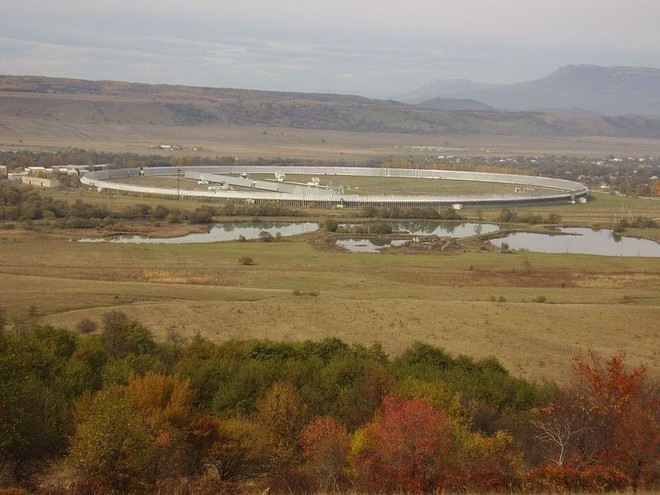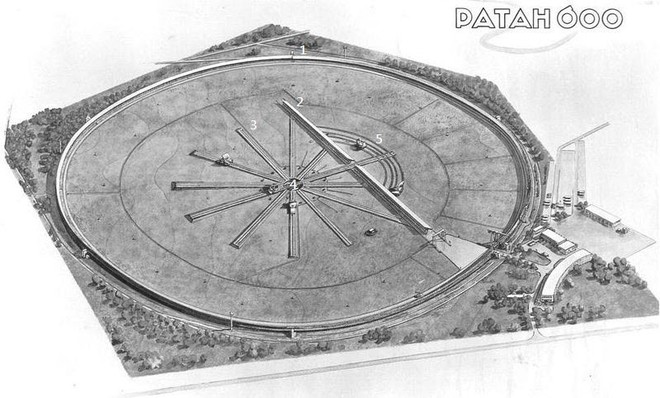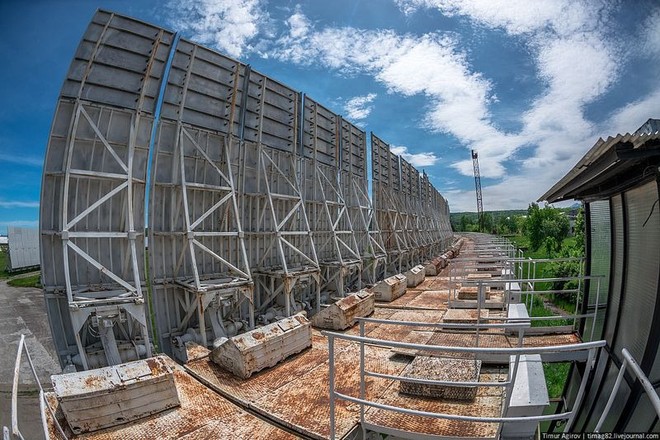Visit the largest radio telescope on the planet
With nearly 900 metal plates in a circle with a diameter of 576 m, RATAN-600 is the largest radio telescope in the world that can track the Sun and seek life in the universe.
Discover radio telescope RATAN-600

RATAN-600 (acronym for Radio Astronomical Telescope of the Academy of Sciences) is a radio telescope located near Zelenchukskaya village in the Caucasus mountain range, Russia.Its height compared to the ground is 970 m.

While most radio telescopes use one or more pan antennas to focus electromagnetic radiation on a signal receiver, RATAN-600 possesses several hundred metal plates capable of signal reflection. television.
Metal plates have the ability to change the position to receive radiation from all directions in the universe to a cone-receiving device in the center.They form a circular fence with a diameter of 576 m.With that size, RATAN-600 becomes the largest radio telescope on the planet.

Structure diagram of RATAN-600: 1- round metal plates;2-metal sheets lined up in straight lines;3 - radial rail system;4- signal receiving device in the center;5 - circle rail.

895 rectangular metal plates make up the largest component of RATAN-600.With a height of 11 m, they are able to respond to signals in the receiver at the center.

RATAN-600 provides about a quarter of data in the field of radio astronomy in Russia.

A special feature of the RATAN-600 is the instantaneous frequency change capability, which allows it to find the source of radiation emission by multiple frequencies in very short time periods.The system can detect radio signals in the frequency range 610 MHz to 30 GHz.That special ability is extremely useful when scientists need to find many sources of radiation.

124 metal sheets with a height of 8.5 m are arranged in straight lines with a length of 400 m.Like shields on the outer ring, their task is also a feedback signal on the receiver.These metal plates can also rotate on a horizontal axis.

The engineers built RATAN-600 in 1968 and it has been operating since 1974.

The main task of the RATAN-600 is to monitor radio waves from the Sun, especially in Sun canopy (solar corona).

RATAN-600 also participated in efforts to find extraterrestrial life.

Straight rail system to move metal plates.

Round rails for people to rotate metal plates in a straight line.
- Close up of the world's largest telescope
- The world's largest alien hunting telescope was born
- Canada participates in manufacturing the largest radio telescope
- Visit the world's largest radio telescope
- China builds the world's largest telescope
- Giant telescope captures signals from the universe
- China relocated more than 9,000 people to hunt people out of space
- China hunts aliens with giant telescopes
- The largest radio telescope in operation
- China revealed Asia's largest telescope
- Chile radio telescope reaches maximum capacity
- The world's largest radio telescope project
 The 11 most unique public toilets in the world
The 11 most unique public toilets in the world Explore the ghost town in Namibia
Explore the ghost town in Namibia Rare historical moments are 'colored', giving us a clearer view of the past
Rare historical moments are 'colored', giving us a clearer view of the past The world famous ghost ship
The world famous ghost ship